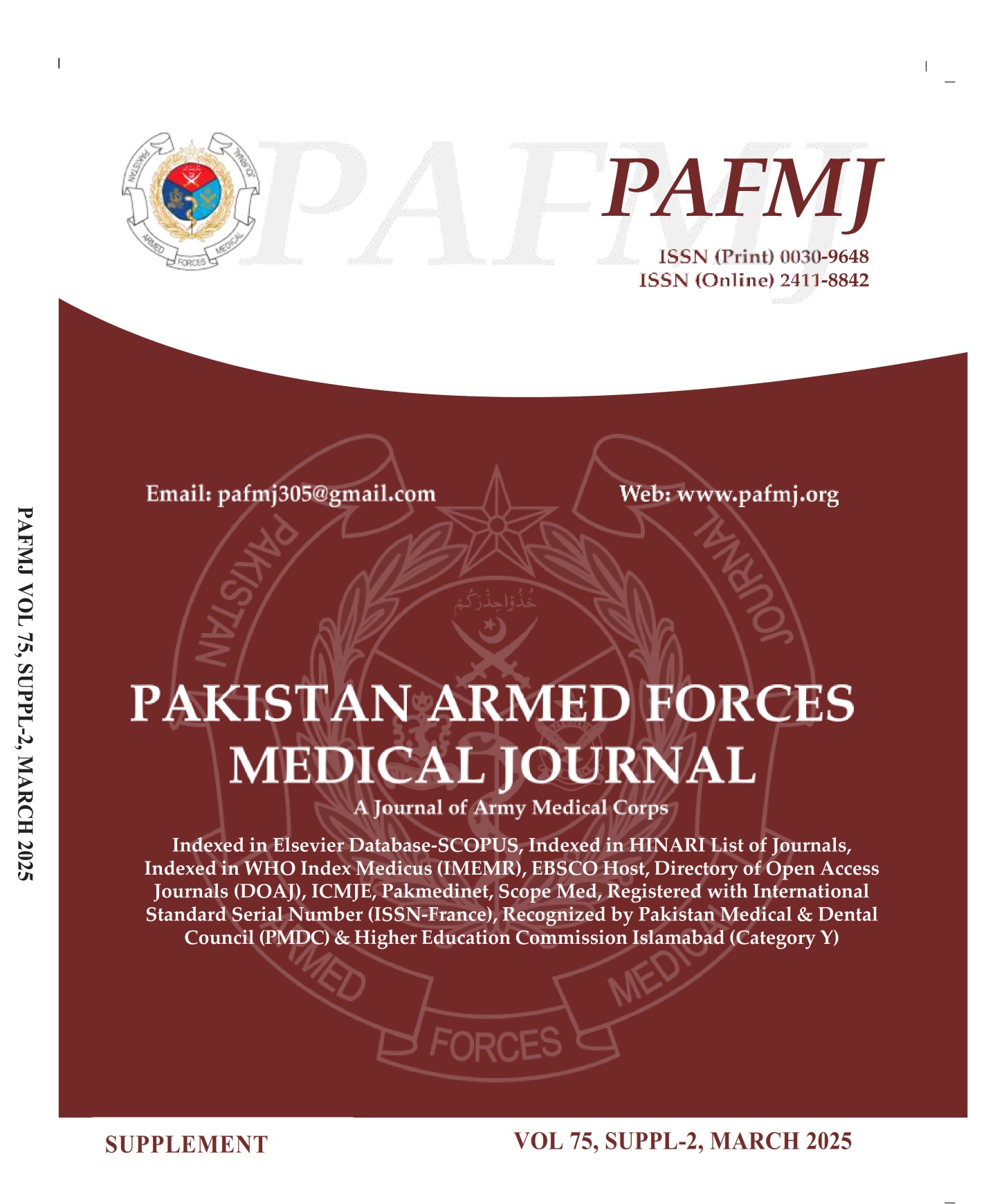Comparison of Tap Block vs Layer by Layer Local Anesthetic Infiltration Patients Undergoing Inguinal Hernia Repair
DOI:
https://doi.org/10.51253/pafmj.v75iSUPPL-2.9382Keywords:
Analgesia, Inguinal Hernia, Transversus Abdominis Plane Block, Wound InfiltrationAbstract
Objective: To compare analgesic efficacy of Transverses Abdominis plane block and layer by layer local anesthetic infiltration patients undergoing inguinal hernia repair.
Study Design: Quasi-Experimental Study.
Place and Duration of Study: Anesthesia Department, Combined Military Hospital, Rawalpindi Pakistan, from Feb to Jul 2022.
Methodology: A total of 80 patients undergoing inguinal hernia repair under spinal anesthesia were enrolled in the study after random distribution and divided into two groups receiving localized wound infiltration (Group A) and receiving Transversus abdominis plane block (Group B). The primary determinants were request to first analgesia and mean total consumption of analgesia post-operatively. Additionally, determining variables were mean postoperative pain scores at 6, 12 and 24 hours.
Results: A total of 80 patients were enrolled in the study with a mean age of 37.53±9.32 years. There was a significantly prolonged time before patient requested first analgesic dose in Transverses Abdominis plane block group as compared to WI group (244.9±66.6 mins vs. 160.3±19.9 mins with a p-value<0.001). Increased dosage of Injection Nalbuphine (26.5±1.74 mg vs. 20.4±1.45 mg, p-value<0.001) and Injection Ketorolac (75.4±6.52 mg vs. 66.7±4.66 mg, p-value<0.001) were consumed in WI group as compared to TAP block group respectively.
Conclusion: TAP block achieves better analgesia when compared with WI as demonstrated increased time to first request for analgesic, lower pain scores and low total analgesic use on the zero post-operative day. The reduced total analgesic consumption can also potentially lead to lower side effect profile and increased satisfaction of patient in regards to postoperative pain control
Downloads
References
Bhandarkar P, Gadgil A, Patil P, Mohan M, Roy N. Estimation of the National Surgical Needs in India by Enumerating the Surgical Procedures in an Urban Community Under Universal Health Coverage. World J Surg 2021; 45(1): 33-40.
https://doi.org/10.1007/s00268-020-05794-7
Wolk S, Meißner T, Linke S, Müssle B, Wierick A, Bogner A, et al. Use of activity tracking in major visceral surgery-the Enhanced Perioperative Mobilization (EPM) trial: study protocol for a randomized controlled trial. Trials 2017; 18(1): 77.
https://doi.org/10.1186/s13063-017-1782-1
Gustafsson UO, Scott MJ, Schwenk W, Demartines N, Roulin D, Francis N, et al. Guidelines for perioperative care in elective colonic surgery: Enhanced Recovery After Surgery (ERAS®) Society recommendations. Clin Nutr 2012; 31(6): 783–800.
https://doi.org/10.1016/j.clnu.2012.08.013
Wolk S, Meißner T, Linke S, Müssle B, Wierick A, Bogner A, et al. Use of activity tracking in major visceral surgery-the Enhanced Perioperative Mobilization (EPM) trial: study protocol for a randomized controlled trial. Trials 2017; 18(1): 77.
https://doi.org/10.1186/s13063-017-1782-1
Rafi AN. Abdominal field block: a new approach via the lumbar triangle. Anaesthesia 2001; 56(10): 1024-6.
https://doi.org/10.1046/j.1365-2044.2001.02279-40.x
Brogi E, Kazan R, Cyr S, Giunta F, Hemmerling MH. Transversus abdominis plane block for postoperative analgesia: A systemic review and meta‑analysis of randomized‑controlled trials. Can J Anesth 2016; 63: 1184‑1196.
Ripolles J, Mezquita MS, Abad A, Calvo J. Analgesic efficacy of ultrasound‑guided blockade of the transversus abdominis plane – A systematic review. Rev Bras Anestesiol 2015; 65: 255‑280
Aveline C, Le Hetet H, Le Roux A, Vautier P, Cognet F, Vinet E, et al. Comparison between ultrasound-guided transversus abdominis plane and conventional ilioinguinal/iliohypogastric nerve blocks for day-case open inguinal hernia repair. Br J Anaesth 2011; 106(3): 380-386.
https://doi.org/10.1093/bja/aeq363
Hebbard P, Fujiwara Y, Shibata Y, Royse C. Ultrasound-guided transversus abdominis plane block. Anaesth Intensive Care 2007; 35: 616-617.
Fredrickson M, Seal P, Haughton J. Early experience with the transversus abdominis plane block in children. Paediatr Anaesth 2008; 18: 891-892.
Osaheni O, Idehen HO, Imarengiaye CO. Analgesia for postoperative myomectomy pain: A comparison of ultrasound-guided transversus abdominis plane block and wound infiltration. Niger J Clin Pract 2020; 23: 1523-1529.
Ahmed M, Abd El‑Hamid A, Ehab EA. Transversus abdominis plane block versus local anaesthetic wound infiltration in patient undergoing open inguinal hernia repair surgery. Ain‑Shams J Anaesthesiol 2016; 9: 280‑283.
Amjad Q, Sharif A, Khan A. Ultrasound‑guided transversus abdominis plane block versus wound infiltration with local anaesthetic agent in abdominal surgeries. Pak Armed Force Med J 2016; 66: 747‑751.
Vijayalakshmi S, Arumugan V, Sumanlata G, Ashok SB. Comparison of analgesic efficacy of transversus abdominis plane block with direct infiltration of local anesthetic into surgical incision in lower abdominal gynecological surgeries. Anaesthesiol Clin Phamacol 2013; 29: 71‑75.
Carney J, McDonnell GJ, Ochanna A, Bhinder R, Laffey GJ. The transversus abdominis plane block provides effective postoperative analgesia in patients undergoing total abdominal hysterectomy. Anesth Analg 2008; 107: 2056‑2060.
Kanazi GE, Aouad MT, Abdallah FW, Khatib MI, Adham AM, Harfoush DW, et al. The analgesic efficacy of subarachnoid morphine in comparison with ultrasound‑guided transversus abdominis plane block after cesarean delivery: A randomized controlled trial. Anesth Analg 2010; 111: 475‑481.
Frassanito L, Pitoni S, Gonnella G, Alfieri S, Del Vicario M, Catarci S, et al. Utility of ultrasound-guided transversus abdominis plane block for day-case inguinal hernia repair. Korean J Anesthesiol 2017; 70: 46–51.
Zhou Y, Chen M, Zhang Y, Zhou H, Yu X, Chen G, et al. Ilioinguinal/iliohypogastric nerve block versus transversus abdominis plane block for pain management following inguinal hernia repair surgery: A systematic review and meta-analysis of randomized controlled trials. Medicine (Baltimore) 2019; 98(42): e17545.
Talib MT, Sikander RI, Ahsan MF. Ultrasound guided transversus abdominis plane (TAP) block is better than local wound infiltration for postoperative pain management in inguinal hernia repair. Anaesth Pain & Intensive Care 2015; 19(4).
Fung D. Measuring patient satisfactions with anaesthesia care: A review 006Ff current 1998; 84: 1089‑1098
Downloads
Published
Issue
Section
License
Copyright (c) 2025 Muhammad Huzaifa Sharif, Syed Qasim Ali Shah, Mirza Hamid Beg, Khalid Buland, Ameer Yasser Zaid, Fahad Hussain

This work is licensed under a Creative Commons Attribution-NonCommercial 4.0 International License.















